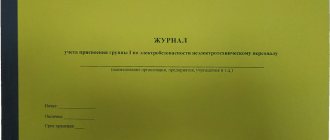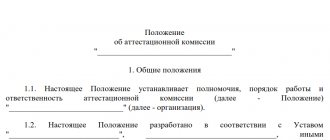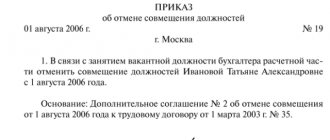Main categories of personnel
All employees can be divided into the following groups: employees and workers.
Employees include the following categories of employees: specialists, management and other employees who may be classified as employees. Personnel categories are distributed in accordance with the regulatory document (All-Russian Classifier of Occupations). This document contains two sections of lists: employee positions and worker professions. The first include employees who hold leadership positions at enterprises and in their structural divisions. This category of personnel may include directors, managers, managers and chief specialists.
Workers may include persons who perform primarily the functions of physical labor and are directly involved in the creation of material assets, maintaining equipment and production premises in working order. Employees are workers who carry out training and subsequent documentation, as well as business maintenance, accounting and control.
Administrative staff
This category of employees ensures the effective functioning of the organization and the resolution of certain emerging managerial and technical issues.
Administrative personnel are usually divided into administrative-managerial, administrative-economic and administrative-technical. Moreover, each subcategory may provide for the classification of workers into managers, specialists and other workers.
The list of professions and positions related to administrative and managerial personnel has not been established. At the same time, it is contained in some regulatory acts of executive authorities (Sample list, approved by Order of the Ministry of Labor of Russia dated 10/14/2013 N 535n, List, approved by Order of the Ministry of Culture of Russia dated 09/03/2020 N 1055, Sample list, approved by Order of Rosselkhoznadzor dated 16.06 .2015 N 418).
In most cases, such personnel include employees who carry out the general management of the organization and its structural divisions, who make and implement decisions on managing internal processes (production, technological and others) in the organization, and are engaged in the preparation and processing of legal, financial, accounting, and personnel documentation ( heads of organizations, heads of structural divisions, deputy managers, accounting, human resources specialists, legal advisers, etc. (clause 7 of the Regulations on the establishment of remuneration systems for employees of federal budgetary, autonomous and government institutions, approved by Decree of the Government of the Russian Federation dated 05.08.2008 N 583, Methodology for calculating the staffing level of state archives based on labor standards, approved by Order of the Federal Archive of January 14, 2004 N 9 (hereinafter referred to as Methodology N 9), paragraph 2 of the Methodological Recommendations, approved by Order of the Ministry of Culture of Russia dated December 30, 2015 N 3453 ).
Administrative and economic personnel include workers who perform various internal economic functions within the organization, including economic support for the organization’s activities, internal information within the organization, operation of buildings, premises, territories, etc. This category of personnel includes positions such as warehouse manager, housekeeping manager, estimator, storekeeper, etc. (Section I of the Model States, approved by Resolution of the Secretariat of the All-Union Central Council of Trade Unions dated May 11, 1990 N 7-22).
Administrative and technical personnel include management employees who are entrusted with the responsibility for organizing technical and operational maintenance, carrying out repair, installation and commissioning work (clause 3.4 of the Rules on labor protection during the operation of electrical installations, approved by Order of the Ministry of Labor of Russia dated July 24, 2013 N 328n ).
The list of positions of employees who perform administrative and technical functions may include: chief engineer, chief technologist, chief designer, chief mechanic, chief power engineer, shop manager, shop mechanic, shop power engineer, senior foreman, etc.
In matters of legal regulation of the activities of administrative personnel, the employer in the LNA can approve its own procedure for organizing the personnel structure.
Factors influencing personnel classification
People are the most important element of the productive forces and the main source of development of the entire economy. Their education, skill, training and motivation are the main tools of any production. Experts have proven that there is a certain dependence between the well-being of people and the competitiveness of the economy on the quality of the category of personnel of an enterprise and organization.
The formation of an enterprise's personnel is influenced by both internal (products, technology and production organization) and external (demographic process, moral and legal norms of society, as well as the nature of the labor market) factors. At the same time, the latter must specify the categories of personnel in terms of macroeconomic parameters: the number of working-age (active) population, its general educational level, employment level and potential labor reserve. These characteristics also determine the qualitative and quantitative parameters of labor resources.
Main and support staff
Many business entities, in addition to their main activities, also perform functions that do not correspond to their main purpose. Therefore, there are such categories of production personnel: main and non-core activities. For example, the first group in industry includes workers of all types of production (main, service and auxiliary), as well as employees of research departments, plant management, security, and warehouses. In other words, all those who are engaged in any way in production or its direct service. The second group includes personnel registered in structures that are on the balance sheet of a business entity, but are not directly related to production. For example, kindergartens, nurseries, housing and communal services, clinics and departmental educational institutions.
The specified classification of personnel at an enterprise is needed for calculating wages and coordinating certain labor criteria with performance indicators. At the same time, the interaction of enterprises with other commercial entities and banking institutions allows us to make this grouping conditional.
Operations staff
Operational personnel include, in particular, workers who directly influence the control bodies of power plants and carry out management and maintenance of power plants on shift (clause 2.6 of the Rules for working with personnel in electric power organizations of the Russian Federation, approved by Order of the Ministry of Fuel and Energy of Russia dated February 19, 2000 N 49) .
In addition, operational personnel include employees of electric energy consumers, authorized by them to take actions to change the technological operating mode and operational state of power lines, equipment and devices at electric power facilities owned by such consumers (power receiving installations) or in cases established by the legislation on the electric power industry - at electric power facilities and energy receiving installations owned by third parties, as well as for coordinating these actions (clause 3 of the Rules for the technological functioning of electric power systems, approved by Decree of the Government of the Russian Federation of August 13, 2018 N 937).
In the field of nuclear energy, operational personnel means operational personnel from among the nuclear plant employees who are on duty during the shift and are allowed to operationally manage technological processes at the nuclear plant (clause 13 of the Requirements, approved by Resolution of the Gosatomnadzor of Russia dated April 15, 1997 N 2).
In relation to other areas of activity, the legislation does not establish the use of this category as mandatory.
Thus, operational personnel are a category of workers who, in the event of an emergency or other situation that interferes with the normal operation of the system, carry out prompt work to eliminate the malfunction. The tasks of this category of personnel also include maintaining the relevant systems.
The employer also has the right to establish a specific list of employee positions that are classified as operational personnel in the LNA. For example, operational personnel include mechanics, electricians, electricians, plumbers, that is, those workers who carry out operational work.
Grouping of personnel depending on the functions performed
Depending on the nature of the functions performed, there is a broader classification of personnel at the enterprise than indicated above: management, specialists, workers and employees.
Managers include employees who head not only enterprises, but also their structural divisions. These include directors, chiefs, managers, managers, foremen, as well as their deputies.
The “specialists” category of personnel includes workers who perform special economic and engineering work. This includes engineers, economists, accountants, standard setters, administrators, legal advisers and sociologists.
Employees are workers who prepare documentation, record keeping, control and business maintenance of business activities. These include accountants, clerks, agents, draftsmen, secretaries and stenographers.
The category of personnel “workers” implies the presence of employees who are directly involved in the creation of various material assets, repair or movement of goods, transportation of passengers, and the provision of material services. In addition to the above, this category includes janitors, cleaners, security guards, couriers and cloakroom attendants.
Production personnel
Production personnel include workers directly involved in the production of products or services or servicing these processes (clause 33 of the Instruction, approved by the State Statistics Committee of the USSR on September 17, 1987 N 17-10-0370 (hereinafter referred to as Instruction N 17-10-0370)).
The main workers include workers who directly create the marketable (gross) output of enterprises and are engaged in the implementation of technological processes, that is, changing the shape, size, position, condition, structure, physical, chemical and other properties of objects of labor (miner, auto mechanic, crane operator, plasterer, machinist, installer, equipment adjuster, metal smelter, molder, plant operator, driver, fireman, mechanic, welder, carpenter, turner, etc.).
Occupations that qualify as essential workers may vary depending on the overall scope of the organization. Thus, the category of main workers may include workers whose labor costs form the basis of production costs.
Ancillary workers include workers engaged in servicing equipment and workplaces in production shops, as well as all workers in auxiliary workshops and farms (nurses, orderlies, paramedics, copying and duplicating machine operators, security guards, carpenters, auxiliary workers, complex maintenance and repair workers and so on.).
Workers within each category can be classified into piece workers and time workers depending on the wage system established in the organization for different positions.
Professions and specialties
This classification of personnel is especially interesting. A profession is represented by a type of work activity, the implementation of which may require special knowledge and skills.
A specialty is a fairly narrow subtype of work activity within a profession. Thus, the profession of a turner itself can cover such specialties as a rotary turner, a boring turner, etc.
The professionalism of the personnel always depends both on the specifics of the activity, products and services, and on the level of technical condition. Each industry is characterized by the presence of specialties. At the same time, there are common professions of employees and workers. An example is the food industry, which has about 850 specialties and professions. However, only a few of them are specific to this industry.
About the professions “state and municipal servant”
Civil servant - who is this?
Worker and employee - these two professions differ from each other, since one produces products with his own hands, and the second solves mental problems. Employees are often found in municipalities and other government structures; they play the role of monitoring the overall process, and do not sell their services and do not perform work. In their activities they are guided by state regulations.
Grouping employees by qualification
This classification is based on the ability to perform work of a certain complexity. In this case, we can talk about qualifications, represented by a set of special knowledge and practical skills that determine the level of preparedness of employees to perform certain professional duties.
The qualifications of management personnel are characterized by their level of education and experience in a specific position. In this case, it is customary to distinguish the following levels of specialists: the highest qualifications (employees with academic degrees and titles); higher qualifications (employees have higher education and practical experience); average qualifications (workers who have specialized secondary education and relevant experience); practitioners (availability of engineering and economic positions among workers).
Skill level
According to the level of qualification, employees are divided into highly qualified, qualified, semi-skilled and unskilled. They can perform work of varying complexity, and they tend to have unequal professional training.
The specified qualification characteristics of employees, along with such as age, gender, length of service and degree of labor mechanization, will serve as the basis for calculations of various types of structures. To increase the efficiency of an enterprise, it is important not only to ascertain the number of employees, but also to study a certain relationship between them.
This approach will allow not only to identify factors and their influence on the results of the enterprise’s activities, but also to calculate the corresponding structural changes with their driving forces and trends. On this basis, a real strategy for the development of labor resources is formed.
Enterprise personnel analysis
Labor resources are studied not only from the point of view of categories, qualifications, professional level, but also according to other characteristics.
The characteristics of an enterprise's personnel are a set of parameters that distinguish a particular workforce or set of employees from comparable groups of employees of other enterprises.
Analysis of personnel characteristics is necessary to improve production processes and make the right management decisions.
The main characteristics are the number of working employees and composition by subordination, age, gender, length of service, education, and functional duties performed.
In this case, skill levels are distributed by rank, class or category.
When analyzing the efficiency of using labor resources, the following are taken into account:
- dynamics of labor force movement (calculation is carried out based on turnover rates for departure, admission and indicators of the constancy of the composition of workers);
- working time balance (formulas allow you to understand whether working time is being used effectively).
An analysis of the enterprise's resource supply forces it to make decisions about changing the staffing table and introducing a new hourly work schedule.
The results of the analysis are usually compiled into a single document or table for subsequent reporting to the director of the enterprise. For each problem, an adequate management solution is proposed.
An example of such a table is presented below:
| Research results | Employer's actions |
| Analysis of personnel movement indicates staff turnover | Additional measures to encourage full-time employees, incentive payments |
| Analysis of the enterprise's supply of labor resources indicates a shortage of labor | Introduction of a shift work schedule, inclusion of new rates in the staffing table, changes in job descriptions regarding the combination of duties |
| Analysis of personnel adaptation indicates a lack of business partnership, the presence of multiple communication barriers | Organization of corporate events with the invitation of family members of the company’s employees, inclusion of a psychologist on the staff |









